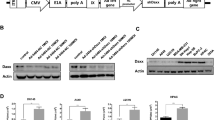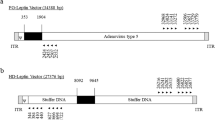Abstract
Genetically modified replication-selective human adenoviruses are currently undergoing testing in the clinical setting as anticancer agents. Coupling the lytic function of these viruses with virus-mediated transgene delivery represents a powerful extension of this treatment. We have designed a unique system for gene delivery from the replicating virus. It takes advantage of the endogenous gene expression control sequences (promoter, splicing, polyadenylation signals) to efficiently and predictably deliver transgenes from the non-essential E3 transcription unit while still maintaining the expression of the remaining E3 genes in the multi-gene transcription unit. In this article, we engineered restriction enzyme sites into the virus genome selectively to delete the ADP gene and replace it with the therapeutic transgenes CD and TNFα. We demonstrate that: (1) transgene expression from this region mirrors the substituted ADP gene; (2) the loss of ADP in these viruses results in infected cells with extended viability and protein synthesis when compared with a wild-type Ad5 infected cell; and (3) expression of surrounding E3 genes can be maintained in such a system. The potential advantages of delivering transgenes from the ADP region of the replicating adenovirus are discussed.
This is a preview of subscription content, access via your institution
Access options
Subscribe to this journal
Receive 12 print issues and online access
$259.00 per year
only $21.58 per issue
Buy this article
- Purchase on Springer Link
- Instant access to full article PDF
Prices may be subject to local taxes which are calculated during checkout









Similar content being viewed by others
References
Barker DD, Berk AJ . Adenovirus proteins from both E1B reading frames are required for transformation of rodent cells by viral infection and DNA transfection [published erratum appears in Virology 1987;158:263] Virology 1987 156: 107–121
Khuri FR et al. A controlled trial of intratumoral ONYX-015, a selectively-replicating adenovirus, in combination with cisplatin and 5-fluorouracil in patients with recurrent head and neck cancer Nat Med 2000 6: 879–885
Heise C, Kirn DH . Replication-selective adenoviruses as oncolytic agents J Clin Invest 2000 105: 847–851
Ganly I et al. A phase I study of Onyx-015, an E1B attenuated adenovirus, administered intratumorally to patients with recurrent head and neck cancer Clin Cancer Res 2000 6: 798–806
Kirn D, Hermiston T, McCormick F . ONYX-015: clinical data are encouraging Nat Med 1998 4: 1341–1342
Hermiston T . Gene delivery from replication-selective viruses: arming guided missiles in the war against cancer J Clin Invest 2000 105: 1169–1172
Hawkins LK et al. Gene delivery from the E3 region of the replicating human adenovirus: evaluation of the 6.7 K/gp19 K region Gene Therapy 2001 8: 1123–1131
Berkner KL, Sharp PA . Generation of adenovirus by transfection of plasmids Nucleic Acids Res 1983 11: 6003–6020
Kelly TJ Jr, Lewis AM Jr . Use of nondefective adenovirus-simian virus 40 hybrids for mapping the simian virus 40 genome J Virol 1973 12: 643–652
Flint SJ et al. Adenovirus transcription. II. RNA sequences complementary to simian virus 40 and adenovirus 2DNA in AD2+ND1- and AD2+ND3-infected cells J Virol 1975 16: 662–673
Wold WS, Tollefson AE, Hermiston TW . E3 transcription unit of adenovirus Curr Top Microbiol Immunol 1995 199: 237–274
Tollefson AE, Scaria A, Saha SK, Wold WS . The 11 600-MW protein encoded by region E3 of adenovirus is expressed early but is greatly amplified at late stages of infection J Virol 1992 66: 3633–3642
Wold WS et al. Immune responses to adenoviruses: viral evasion mechanisms and their implications for the clinic Curr Opin Immunol 1999 11: 380–386
Tollefson AE et al. The E3-11.6-kDa adenovirus death protein (ADP) is required for efficient cell death: characterization of cells infected with adp mutants Virology 1996 220: 152–162
Tollefson AE et al. The adenovirus death protein (E3-11.6 K) is required at very late stages of infection for efficient cell lysis and release of adenovirus from infected cells J Virol 1996 70: 2296–2306
Scaria A, Wold WS . Fine-mapping of sequences that suppress splicing in the E3 complex transcription unit of adenovirus Virology 1994 205: 406–416
Hawkins LK, Hermiston TW . Gene Delivery from the E3 region of the replicating human adenovirus: evaluation of the E3B region Gene Therapy 2001 8: 1142–1148
Wang AM et al. Molecular cloning of the complementary DNA for human tumor necrosis factor Science 1985 228: 149–154
Carswell EA et al. An endotoxin-induced serum factor that causes necrosis of tumors Proc Natl Acad Sci USA 1975 72: 3666–3670
Ohno S et al. Increased therapeutic efficacy induced by tumor necrosis factor alpha combined with platinum complexes and whole-body hyperthermia in rats Cancer Res 1992 52: 4096–4101
Krosnick JA, Mule JJ, McIntosh JK, Rosenberg SA . Augmentation of antitumor efficacy by the combination of recombinant tumor necrosis factor and chemotherapeutic agents in vivo Cancer Res 1989 49: 3729–3733
Lev-Chelouche D et al. Limb desmoid tumors: a possible role for isolated limb perfusion with tumor necrosis factor-alpha and melphalan Surgery 1999 126: 963–967
Kimura K, Gelmann EP . Tumor necrosis factor-alpha and Fas activate complementary Fas-associated death domain-dependent pathways that enhance apoptosis induced by gamma-irradiation J Biol Chem 2000 275: 8610–8617
Shimomura K et al. Recombinant human tumor necrosis factor-alpha: thrombus formation is a cause of anti-tumor activity Int J Cancer 1988 41: 243–247
Kamada H et al. In vitro remodeling of tumor vascular endothelial cells using conditioned medium from various tumor cells and their sensitivity to TNF-alpha Biochem Biophys Res Commun 2000 268: 809–813
Stoelcker B et al. Tumor necrosis factor induces tumor necrosis via tumor necrosis factor receptor type 1-expressing endothelial cells of the tumor vasculature Am J Pathol 2000 156: 1171–1176
Feinberg B et al. A phase I trial of intravenously-administered recombinant tumor necrosis factor-alpha in cancer patients J Clin Oncol 1988 6: 1328–1334
Sherman ML et al. Recombinant human tumor necrosis factor administered as a five-day continuous infusion in cancer patients: phase I toxicity and effects on lipid metabolism J Clin Oncol 1988 6: 344–350
Spriggs DR et al. Recombinant human tumor necrosis factor administered as a 24-hour intravenous infusion. A phase I and pharmacologic study J Natl Cancer Inst 1988 80: 1039–1044
Moritz T et al. Phase I study of recombinant human tumor necrosis factor alpha in advanced malignant disease Cancer Immunol Immunother 1989 29: 144–150
Ramshaw IA et al. Cytokines and immunity to viral infections Immunol Rev 1997 159: 119–135
Wold WS, Hermiston TW Tollefson AE . Adenovirus proteins that subvert host defenses Trends Microbiol 1994 2: 437–443
Gooding LR . Regulation of TNF-mediated cell death and inflammation by human adenoviruses Infect Agents Dis 1994 3: 106–115
Czarniecki CW . The role of tumor necrosis factor in viral disease Antiviral Res 1993 22: 223–258
Wold WS, Tollefson AE . Adenovirus E3 Proteins: 14.7 K, RID, and gp19 K inhibit immune-induced cell death; adenovirus death protein promotes cell death Semin Virol 1998 8: 515–523
Wildner O et al. Adenoviral vectors capable of replication improve the efficacy of HSVtk/GCV suicide gene therapy of cancer Gene Therapy 1999 6: 57–62
Freytag SO et al. A novel three-pronged approach to kill cancer cells selectively: concomitant viral, double suicide gene, and radiotherapy (see comments) Hum Gene Ther 1998 9: 1323–1333
Kammann M, Laufs J, Schell J, Gronenborn B . Rapid insertional mutagenesis of DNA by polymerase chain reaction (PCR) Nucleic Acids Res 1989 17: 5404
Acknowledgements
Thank you to Dr Jerry Shen for critical reading of the manuscript, Dr William SM Wold for E3 antibodies and Ynez Dugan for manuscript preparation and Maxine Bauzon for excellent technical assistance.
Author information
Authors and Affiliations
Rights and permissions
About this article
Cite this article
Hawkins, L., Hermiston, T. Gene delivery from the E3 region of replicating human adenovirus: evaluation of the ADP region. Gene Ther 8, 1132–1141 (2001). https://doi.org/10.1038/sj.gt.3301508
Received:
Accepted:
Published:
Issue Date:
DOI: https://doi.org/10.1038/sj.gt.3301508
Keywords
This article is cited by
-
Combining virotherapy and angiotherapy for the treatment of breast cancer
Cancer Gene Therapy (2013)
-
Second-generation HIF-activated oncolytic adenoviruses with improved replication, oncolytic, and antitumor efficacy
Gene Therapy (2010)
-
Armed replicating adenoviruses for cancer virotherapy
Cancer Gene Therapy (2009)
-
Deletion of the E3-6.7K/gp19K region reduces the persistence of wild-type adenovirus in a permissive tumor model in Syrian hamsters
Cancer Gene Therapy (2009)
-
Comparison of the E3 and L3 regions for arming oncolytic adenoviruses to achieve a high level of tumor-specific transgene expression
Cancer Gene Therapy (2008)



